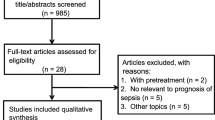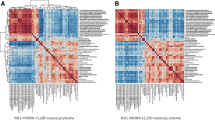Abstract
Purpose
To determine the global metabolomic profile as measured in circulating plasma from surviving and non-surviving patients with community-acquired pneumonia (CAP) and sepsis.
Methods
Random, outcome-stratified case–control sample from a prospective study of 1,895 patients hospitalized with CAP and sepsis. Cases (n = 15) were adults who died before 90 days, and controls (n = 15) were adults who survived, matched on demographics, infection type, and procalcitonin. We determined the global metabolomic profile in the first emergency department blood sample using non-targeted mass-spectrometry. We derived metabolite-based prognostic models for 90-day mortality. We determined if metabolites stimulated cytokine production by differentiated Thp1 monocytes in vitro, and validated metabolite profiles in mouse liver and kidney homogenates at 8 h in cecal ligation and puncture (CLP) sepsis.
Results
We identified 423 small molecules, of which the relative levels of 70 (17 %) were different between survivors and non-survivors (p ≤ 0.05). Broad differences were present in pathways of oxidative stress, bile acid metabolism, and stress response. Metabolite-based prognostic models for 90-day survival performed modestly (AUC = 0.67, 95 % CI 0.48, 0.81). Five nucleic acid metabolites were greater in non-survivors (p ≤ 0.05). Of these, pseudouridine increased monocyte expression of TNFα and IL1β versus control (p < 0.05). Pseudouridine was also increased in liver and kidney homogenates from CLP mice versus sham (p < 0.05 for both).
Conclusions
Although replication is required, we show the global metabolomic profile in plasma broadly differs between survivors and non-survivors of CAP and sepsis. Metabolite-based prognostic models had modest performance, though metabolites of oxidative stress may act as putative damage-associated molecular patterns.




Similar content being viewed by others
References
Poeze M, Ramsay G, Gerlach H, Rubulotta F, Levy M (2004) An international sepsis survey: a study of doctors’ knowledge and perception about sepsis. Crit Care 8:R409–R413
Ferrer R, Artigas A, Levy MM, Blanco J, Gonzalez-Diaz G, Garnacho-Montero J, Ibanez J, Palencia E, Quintana M, de la Torre-Prados MV (2008) Improvement in process of care and outcome after a multicenter severe sepsis educational program in Spain. JAMA 299:2294–2303
Angus DC, Linde-Zwirble WT, Lidicker J, Clermont G, Carcillo J, Pinsky MR (2001) Epidemiology of severe sepsis in the United States: analysis of incidence, outcome, and associated costs of care. Crit Care Med 29:1303–1310
Pierrakos C, Vincent JL (2010) Sepsis biomarkers: a review. Crit Care 14:R15
Calvano SE, Xiao W, Richards DR, Felciano RM, Baker HV, Cho RJ, Chen RO, Brownstein BH, Cobb JP, Tschoeke SK, Miller-Graziano C, Moldawer LL, Mindrinos MN, Davis RW, Tompkins RG, Lowry SF (2005) A network-based analysis of systemic inflammation in humans. Nature 437:1032–1037
Jones AE, Shapiro NI, Trzeciak S, Arnold RC, Claremont HA, Kline JA (2010) Lactate clearance vs central venous oxygen saturation as goals of early sepsis therapy: a randomized clinical trial. JAMA 303:739–746
Ranieri VM, Thompson BT, Barie PS, Dhainaut JF, Douglas IS, Finfer S, Gardlund B, Marshall JC, Rhodes A, Artigas A, Payen D, Tenhunen J, Al-Khalidi HR, Thompson V, Janes J, Macias WL, Vangerow B, Williams MD (2012) Drotrecogin alfa (activated) in adults with septic shock. N Engl J Med 366:2055–2064
Wong HR, Cvijanovich NZ, Allen GL, Thomas NJ, Freishtat RJ, Anas N, Meyer K, Checchia PA, Lin R, Shanley TP, Bigham MT, Wheeler DS, Doughty LA, Tegtmeyer K, Poynter SE, Kaplan JM, Chima RS, Stalets E, Basu RK, Varisco BM, Barr FE (2011) Validation of a gene expression-based subclassification strategy for pediatric septic shock. Crit Care Med 39:2511–2517
Serkova NJ, Standiford TJ, Stringer KA (2011) The emerging field of quantitative blood metabolomics for biomarker discovery in critical illnesses. Am J Resp Crit Care Med 184(6):647–655
Izquierdo-Garcia JL, Nin N, Ruiz-Cabello J, Rojas Y, de Paula M, Lopez-Cuenca S, Morales L, Martinez-Caro L, Fernandez-Segoviano P, Esteban A, Lorente JA (2011) A metabolomic approach for diagnosis of experimental sepsis. Intensive Care Med [Epub ahead of print]
Liu XR, Zheng XF, Ji SZ, Lv YH, Zheng DY, Xia ZF, Zhang WD (2010) Metabolomic analysis of thermally injured and/or septic rats. Burns 36:992–998
Hinkelbein J, Feldmann RE Jr, Peterka A, Schubert C, Schelshorn D, Maurer MH, Kalenka A (2007) Alterations in cerebral metabolomics and proteomic expression during sepsis. Curr Neurovasc Res 4:280–288
Xu PB, Lin ZY, Meng HB, Yan SK, Yang Y, Liu XR, Li JB, Deng XM, Zhang WD (2008) A metabonomic approach to early prognostic evaluation of experimental sepsis. J Infect 56:474–481
Adams Wilson JR, Morandi A, Girard TD, Thompson JL, Boomershine CS, Shintani AK, Ely EW, Pandharipande PP (2012) The association of the kynurenine pathway of tryptophan metabolism with acute brain dysfunction during critical illness. Crit Care Med 40:835–841
Bruegel M, Ludwig U, Kleinhempel A, Petros S, Kortz L, Ceglarek U, Holdt LM, Thiery J, Fiedler GM (2012) Sepsis-associated changes of the arachidonic acid metabolism and their diagnostic potential in septic patients. Crit Care Med 40:1478–1486
Gough MS, Morgan MA, Mack CM, Darling DC, Frasier LM, Doolin KP, Apostolakos MJ, Stewart JC, Graves BT, Arning E, Bottiglieri T, Mooney RA, Frampton MW, Pietropaoli AP (2011) The ratio of arginine to dimethylarginines is reduced and predicts outcomes in patients with severe sepsis. Crit Care Med 39:1351–1358
Semmler A, Smulders Y, Struys E, Smith D, Moskau S, Blom H, Linnebank M (2008) Methionine metabolism in an animal model of sepsis. Clin Chem Lab Med 46:1398–1402
Stringer KA, Serkova NJ, Karnovsky A, Guire K, Paine R 3rd, Standiford TJ (2011) Metabolic consequences of sepsis-induced acute lung injury revealed by plasma 1H-nuclear magnetic resonance quantitative metabolomics and computational analysis. Am J Physiol Lung Cell Mol Physiol 300:L4–L11
Breslow NE, Holubkov R (1997) Maximum likelihood estimation of logistic regression parameters under two phase, outcome-dependent sampling. J R Stat Soc Ser C Appl Stat 59:447–461
Selberg O, Hecker H, Martin M, Klos A, Bautsch W, Kohl J (2000) Discrimination of sepsis and systemic inflammatory response syndrome by determination of circulating plasma concentrations of procalcitonin, protein complement 3a, and interleukin-6. Crit Care Med 28:2793–2798
Lawton KA, Berger A, Mitchell M, Milgram KE, Evans AM, Guo L, Hanson RW, Kalhan SC, Ryals JA, Milburn MV (2008) Analysis of the adult human plasma metabolome. Pharmacogenomics 9:383–397
Dehaven CD, Evans AM, Dai H, Lawton KA (2010) Organization of GC/MS and LC/MS metabolomics data into chemical libraries. J Cheminform 2:9
Bleiblo F, Michael P, Brabant D, Ramana CV, Tai T, Saleh M, Parrillo JE, Kumar A (2012) The role of immunostimulatory nucleic acids in septic shock. Int J Clin Exp Med 5:1–23
Storey JD, Tibshirani R (2003) Statistical significance for genomewide studies. Proc Nat Acad Sci USA 100:9440–9445
Green RM, Beier D, Gollan JL (1996) Regulation of hepatocyte bile salt transporters by endotoxin and inflammatory cytokines in rodents. Gastroenterology 111:193–198
Trauner M, Arrese M, Lee H, Boyer JL, Karpen SJ (1998) Endotoxin downregulates rat hepatic ntcp gene expression via decreased activity of critical transcription factors. J Clin Inv 101:2092–2100
Han X, Fink MP, Uchiyama T, Yang R, Delude RL (2004) Increased iNOS activity is essential for hepatic epithelial tight junction dysfunction in endotoxemic mice. Am J Physiol Gastrointest Liver Physiol 286:G126–G136
Chernow B, Alexander HR, Smallridge RC, Thompson WR, Cook D, Beardsley D, Fink MP, Lake CR, Fletcher JR (1987) Hormonal responses to graded surgical stress. Arch Int Med 147:1273–1278
Hasselgren PO, Pedersen P, Sax HC, Warner BW, Fischer JE (1988) Current concepts of protein turnover and amino acid transport in liver and skeletal muscle during sepsis. Arch Surg 123:992–999
Lagendijk J, Ubbink JB, Vermaak WJ (1995) The determination of allantoin, a possible indicator of oxidant status, in human plasma. J Chromatogr Sci 33:186–193
Ramazzina I, Folli C, Secchi A, Berni R, Percudani R (2006) Completing the uric acid degradation pathway through phylogenetic comparison of whole genomes. Nat Chem Biol 2:144–148
Shi Y, Zheng W, Rock KL (2000) Cell injury releases endogenous adjuvants that stimulate cytotoxic T cell responses. Proc Nat Acad Sci USA 97:14590–14595
Ishii KJ, Suzuki K, Coban C, Takeshita F, Itoh Y, Matoba H, Kohn LD, Klinman DM (2001) Genomic DNA released by dying cells induces the maturation of APCs. J Immunol 167:2602–2607
Shi Y, Evans JE, Rock KL (2003) Molecular identification of a danger signal that alerts the immune system to dying cells. Nature 425:516–521
Tavazzi B, Batocchi AP, Amorini AM, Nociti V, D’Urso S, Longo S, Gullotta S, Picardi M, Lazzarino G (2011) Serum metabolic profile in multiple sclerosis patients. Mult Scler Int 2011:167156
Amuro Y, Nakaoka H, Shimomura S, Fujikura M, Yamamoto T, Tamura S, Hada T, Higashino K (1988) Serum pseudouridine as a biochemical marker in patients with hepatocellular carcinoma. Clin Chim Acta 178:151–158
Angus DC, Yang L, Kong L, Kellum JA, Delude RL, Tracey KJ, Weissfeld L (2007) Circulating high-mobility group box 1 (HMGB1) concentrations are elevated in both uncomplicated pneumonia and pneumonia with severe sepsis. Crit Care Med 35:1061–1067
Suhre K, Shin SY, Petersen AK, Mohney RP, Meredith D, Wagele B, Altmaier E, Deloukas P, Erdmann J, Grundberg E, Hammond CJ, de Angelis MH, Kastenmuller G, Kottgen A, Kronenberg F, Mangino M, Meisinger C, Meitinger T, Mewes HW, Milburn MV, Prehn C, Raffler J, Ried JS, Romisch-Margl W, Samani NJ, Small KS, Wichmann HE, Zhai G, Illig T, Spector TD, Adamski J, Soranzo N, Gieger C (2011) Human metabolic individuality in biomedical and pharmaceutical research. Nature 477:54–60
Sreekumar A, Poisson LM, Rajendiran TM, Khan AP, Cao Q, Yu J, Laxman B, Mehra R, Lonigro RJ, Li Y, Nyati MK, Ahsan A, Kalyana-Sundaram S, Han B, Cao X, Byun J, Omenn GS, Ghosh D, Pennathur S, Alexander DC, Berger A, Shuster JR, Wei JT, Varambally S, Beecher C, Chinnaiyan AM (2009) Metabolomic profiles delineate potential role for sarcosine in prostate cancer progression. Nature 457:910–914
Pan Z, Raftery D (2007) Comparing and combining NMR spectroscopy and mass spectrometry in metabolomics. Anal Bioanal Chem 387:525–527
Beier K, Eppanapally S, Bazick HS, Chang D, Mahadevappa K, Gibbons FK, Christopher KB (2011) Elevation of blood urea nitrogen is predictive of long-term mortality in critically ill patients independent of “normal” creatinine. Crit Care Med 39:305–313
Acknowledgments
This work was supported in part by funding from the National Institutes of Health (K23 GM083215—Yende; 1K23GM104022-01-Seymour). The GenIMS study was funded by National Institute of General Medical Sciences and National Institutes of Health grant R01 GM61992 (Angus, Kellum) with additional support from GlaxoSmithKline for enrollment and clinical data collection and Diagnostic Products Corporation for the cytokine assays. These funding sources had no role in the design and conduct of the study; collection, management, analysis, and interpretation of the data; or in the preparation, review, or approval of the manuscript. Bell and Mohney are employees of Metabolon, Inc. and, as such, have affiliations with or financial involvement with Metabolon, Inc. The authors have no other relevant affiliations or financial involvement with any organization or entity with a financial interest in or financial conflict with the subject matter or materials discussed in the manuscript apart from those disclosed.
Author information
Authors and Affiliations
Corresponding author
Additional information
On behalf of the Genetic and Inflammatory Markers of Sepsis (GenIMS) investigators
Electronic supplementary material
Below is the link to the electronic supplementary material.
Rights and permissions
About this article
Cite this article
Seymour, C.W., Yende, S., Scott, M.J. et al. Metabolomics in pneumonia and sepsis: an analysis of the GenIMS cohort study. Intensive Care Med 39, 1423–1434 (2013). https://doi.org/10.1007/s00134-013-2935-7
Received:
Accepted:
Published:
Issue Date:
DOI: https://doi.org/10.1007/s00134-013-2935-7




